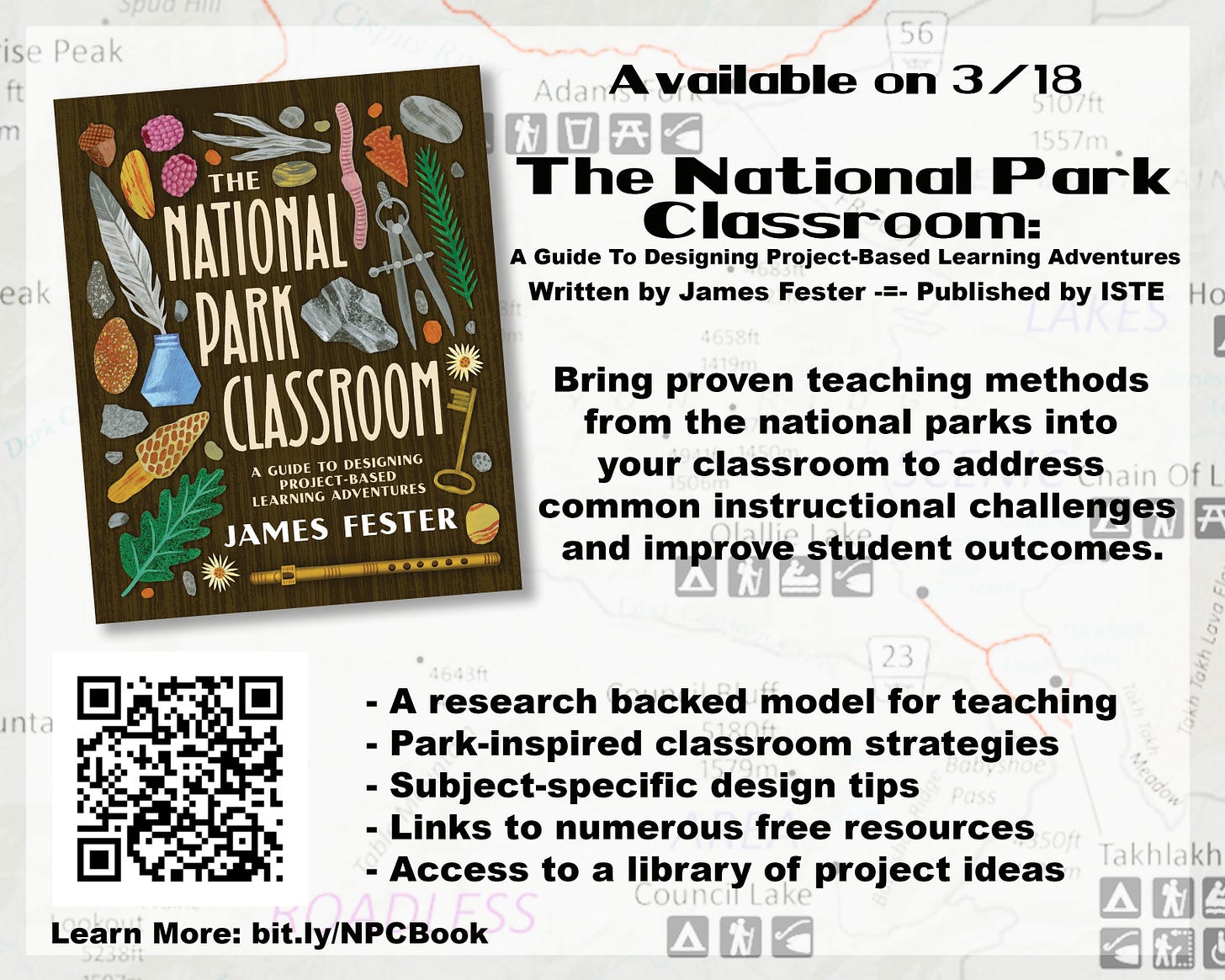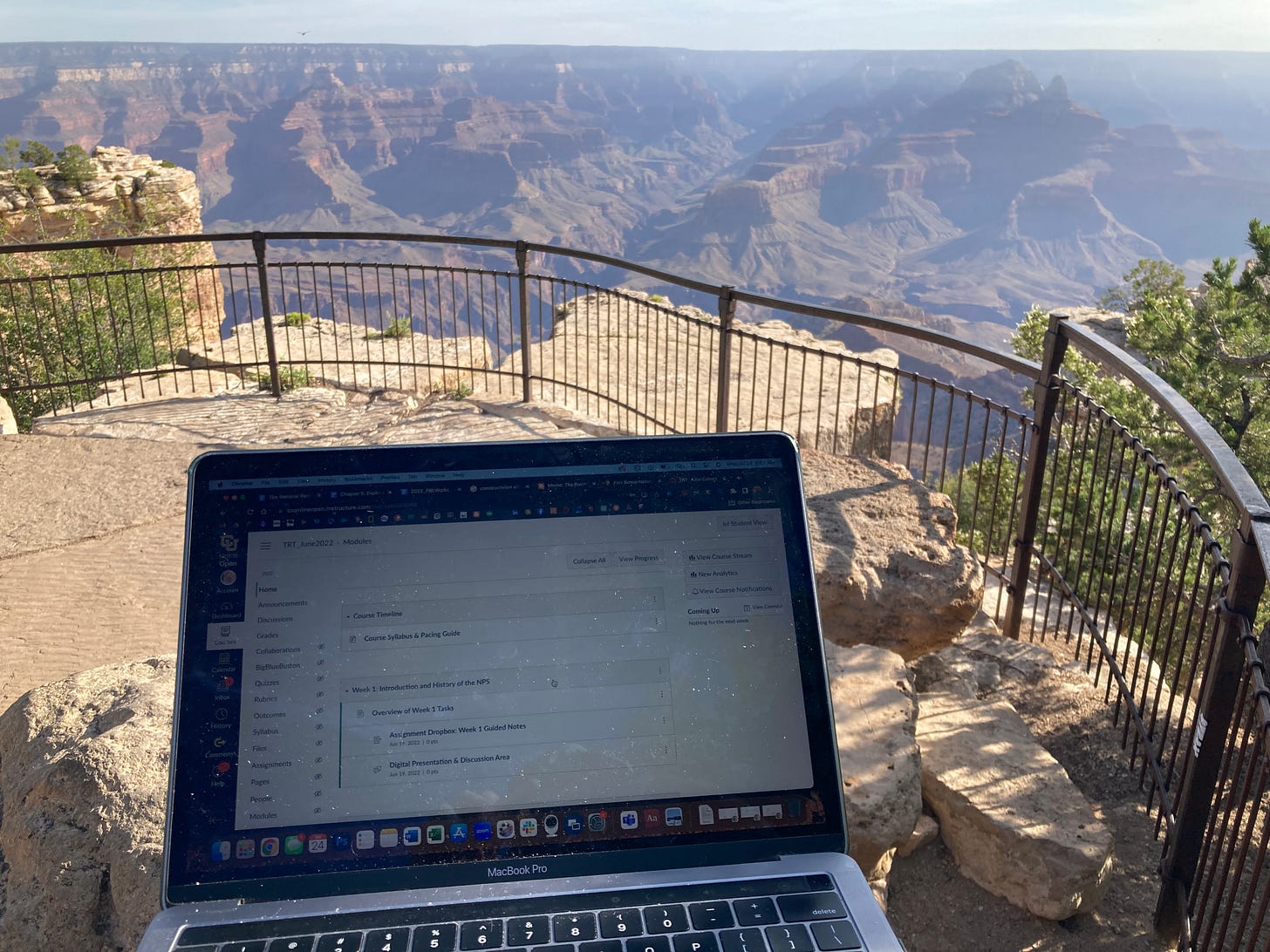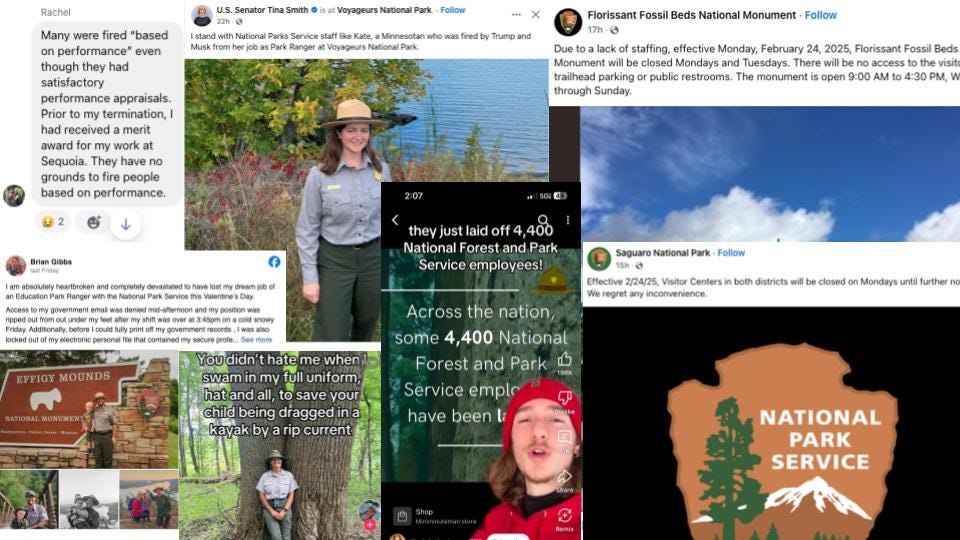Teaching the Value of Parks
Public lands need protecting now more than ever, and any long-term strategy needs to include demonstrating their value to our learners.
“…our national heritage is richer than just scenic features; the realization is coming that perhaps our greatest national heritage is nature itself, with all its complexity and its abundance of life, which, when combined with great scenic beauty as it is in the national parks, becomes of unlimited value.” - George Melendez Wright.
Hello friends. To say it has been rough for park lovers and supporters recently would be an understatement, but it's nothing compared to what 1,000+ NPS members who have been callously cast aside have had to endure. Before you begin reading I’d like to invite you to take a moment, just a few minutes, to look up the contact information of a park unit you feel connected to using the public information form in the contact section and let them know they are values. Just a short message may not seem like anything, but I’ve already reached out to a couple of people I collaborated with in the past and they were grateful!
Three quick reminders/announcements;
Applications for the Spring 2025 Classroom Ranger cohort are still open! This is a fantastic opportunity for educators interested in learning more about the “how” of education within our public lands, and you can learn more about this program and apply here —> CLICK HERE
In less than a month The National Park Classroom will be ready for release! I am very excited for this, my first solo title, to finally be available after more than two years of work! Learn more about the book and reserve your copy here → CLICK HERE
This week we will launch our second webinar in our monthly series focused on the framework underpinning the book. If you’d like to learn more about how to “teach like a ranger” Note: This webinar is only open to members of the National Park Classroom Facebook group → CLICK HERE
The Short Read
We may be at the end of Black History Month, but if you visit your national parks then every month is Black History Month! Here is a National Geographic article that shares the connection between Black history and our parks.
The Long Read - Protecting Parks by Teaching Value
Before we get too far into this article, I’d like to share a story from my upcoming book, specifically from the conclusion - so spoiler alert!
While I was writing the National Park Classroom, I took every opportunity to visit as many national parks as I could to gain a current, on-the-ground perspective on many of the things I was writing about to make sure they were indeed representative of teaching and learning in parks. In June, I had the opportunity to visit the Grand Canyon, something I was exceptionally excited about because of its status and storied place in the larger national parks narrative. I arrived before sunrise and had an entire itinerary that was going to focus on finding every single learning opportunity that I could find, especially those led by the park’s rangers. It was going to be a fantastic day; take a hike, attend a program, and then do this;
But what’s that they say about the plans of mice and men?
Despite it being the height of the visitation season, the educational offerings that day were lackluster at best. There were a total of four mostly canned programs held throughout the park, one of which was canceled due to weather. The park’s main visitor center was only open for a few hours due to staffing issues. Despite spending most of my day hiking along the Rim Trail and visiting many of the park's most iconic views and gathering points, I saw zero roving interpretive rangers, and I wasn’t the only one who was disappointed. There were more than a few young visitors who were trying to earn their Junior Ranger badges which required the signature of a park ranger, and more than a few of them openly lamented the fact that they couldn’t find a single one despite lots of searching.
When the visitors center finally did open and I had the opportunity to inquire as to where all the flat hats had gone, I got a very frank response from the only full-time ranger I saw all day. Park staff had been cut and relocated due to the ballooning costs associated with a critical infrastructure project for the park; the Transcanyon Waterline or TCWL. If you didn’t already know, all of the water used by visitors at the more popular south rim comes from the north rim via a giant pipe that goes down into the canyon and is pumped back up the other side.
The project was so expensive that cuts were required to complete it and many of them came from “non-essential staff” meaning the first people who got reassigned or axed were rangers dedicated to educational programs and visitor experience. And apparently, this wasn’t the first year this had happened due to the TCWL. The ranger then went on to tell me that most of the interpretive hires from the previous season had not come back because the vast majority found themselves reassigned to things like parking lot duty or filling in for maintenance rather than getting to fulfill their desired role interacting with the public. She told me one of her best friends had actually just quit part way through the previous season, saying “this isn’t what I signed up for” Can you imagine being a national park ranger and finally being hired at what could arguably be considered the Rolls-Royce of national parks only to decide halfway through the season to quit because it was so unfulfilling?
To be clear, I am not trying to throw shade or blame on the NPS by telling this story. It is obviously not the fault of park rangers who are doing their best under incredibly trying circumstances. It is probably not the fault of park administrators making the reassignments as their budgets and priorities are being set by people in far off Washington DC, the vast majority of whom have never set foot in the park and even if they have parks in their district routinely vote against them.
I’m simply stating facts - that when push comes to shove, there is a tendency to undervalue what is arguably one of the most essential parts of the national park experience - the people who “speak out on behalf of the trees and the mountains, who have no voice” and help share the value of parks with visitors. I concluded this section of my book by saying, “We need visitors to come away feeling invested in these places and with memories that make them want to support them in the future.” But if all the rangers are busy helping park cars, who is going to do that? Well, prepare yourself, because we may find out this summer.
What we are beginning to see now at parks across the country is essentially what I experienced at the Grand Canyon but system-wide. We are seeing the people most responsible for ensuring the next generation of conservationists walk away understanding the value of our public lands cast aside by people who have little interest in them unless you are talking about natural resources that can be extracted.
But what can be done about this? I absolutely empathize with all of you reading this who feel equal parts powerless and distraught when you open up your social media feeds or email boxes only to find another post or story from a formally employed ranger lamenting the loss of their dream job.
But keeping your fingers crossed that a “good administration” comes along soon and undoes all the stuff the “bad administration” does isn’t a winning strategy for public lands, at least not long term. But fear not fellow teachers because educators are better positioned than most to help us win the long game when it comes to the future security of our parks AND there is something we can all do right now to ensure that situations like what we’re seeing never happen again - we all need to all make sure that every student that enters our classroom doesn’t leave without understanding the value of America’s best idea.
If every teacher in America made sure that their students saw national parks as more than just places to hike, camp, or take some “lit selfies” then those few among them who grow up to eventually sit in places of authority and decision-making would be that much less likely to tolerate behavior like what is going on right now. And the good news is, we’re starting this race 3/4 of the way down the track already as research from The Pew Institute proves that the NPS is the most trusted and popular government agency, and this belief transcends partisan schism in a way that very few other things do today.
But how does one teach “value” especially when many of the learners in your classroom have not yet visited one of these places? Here are a couple of suggestions and ideas of how to make these important connections for all of our learners;
Help them to understand why these places have been set aside. You may be familiar with the quote, “We only value what we understand” so first things first you really want students to understand these places and what makes them so unique and special. A middle school teacher that I interviewed for my book had a great unit that addressed her learning goals around research and writing while teaching value; she would give every single one of her students one of the more obscure national park units (Thaddeus Kosciuszko NM anyone?) and then challenged them to write a persuasive piece arguing their unit was the most important. The challenge required students to dig in and find the value in something that they had never even heard of previously, and despite only getting to look at one obscure park unit, many left with the concept of value and parks being deeply connected. One student's reflection at the end of this project, “To be honest, I am still not sure if I would visit this place, but I recognize that many, many people see it as an essential part of who they are, and that makes me feel like it should be protected.”
Help them find ways of providing service. There’s been a lot of research showing the connection between motivation and helping. Specifically, when people have to complete a task that only benefits them, they are less likely to complete it than if there is a visible benefit to others. Humans are, at least according to this body of research, hardwired to be helpers. So, if you want your students to see the value in something, they need opportunities to feel as though they have made a meaningful contribution to it. This can be done in many different ways, such as offering the final products that they create to the parks, sharing their findings with park professionals, or just simply framing projects in a way where their tasks fulfill a need that has yet to be met. For example, learners in West Virginia worked with New River Gorge National Park and their local chamber of commerce to boost tourism through the creation of a scavenger hunt. While the project was of individual benefit in the sense that it resulted in the students getting a grade or making their teacher happy, they were doubly motivated because they knew their work meant something and by the end of the project they felt much more invested.
Equip them with what they need to “Find their Park”. There are many barriers to visitation, but interestingly one of the biggest is simply not knowing what national parks are for or how to get to them there. So while you’re talking about far-off places or centering your lessons on parks as phenomena, make sure you also share with students the how and why of visiting them in person. Even simple changes to the way that you talk about these places, such as changing “if you visit” to “when you visit” can have an impact on whether or not a student feels that these places and experiences you’re talking about in class are within their reach.
Every learner who leaves your classroom having made an emotional connect to a park unit is one more that will someday take up the banner of protecting the places, and the people, who enable all of us to enjoy these special places!
Fester’s Finds
US Fish and Wildlife Black Footed Ferret Curriculum - who doesn’t love a ferret? This expansive curriculum addresses all sorts of learning standards through the lens of one of North America’s coolest mammals! https://cpw.widen.net/s/khrfmwwxh6/wildaboutblackfootedferretsfinalweb?fbclid=IwY2xjawIncFZleHRuA2FlbQIxMAABHTOHyH5_R_hv02khbanMvPs3xIZD9YCf_f74LBNJMOdEgHeJ5iFLvZh_FA_aem_17yJGrlzM-yjS7wGUjBuDw
Snowshoe Adventure Book from Crater Lake - An interesting idea for a literacy-focused project. Use this project as an exemplar to help students create their own reading-driven creative adventures! https://www.nps.gov/rlc/craterlake/crater-lake-snowshoe-adventure-the-book.htm
Land Use Debate Unit from Olympic National Park - This unit from the now defunct PBS America’s Field Guide project helps learners better understand the trade-offs involved in managing our public lands. https://www.nps.gov/common/uploads/teachers/lessonplans/Salmon%20vs.%20Dams_The%20Dam%20Removal%20Debate%20on%20the%20Elwha%20River.pdf?fbclid=IwY2xjawInb45leHRuA2FlbQIxMAABHfKjxogBTSSXox_vgOkMw0HDw939lCZx9qid13MA5S_IHFdkyakAKhiXwA_aem_TlIMFOOp72T1-recTWK-SQ
Public Lands Curriculum - Developed by the Wilderness Society, this five-lesson unit teaches learners about the importance and vulnerability of our public lands - https://drive.google.com/file/d/1osT1Poo2rxgy9hNZEplBvN8AvfM_Qjyj/view?usp=drive_link
US National Parks Guide - A visually stunning guide to our national parks perfect for the younger learners in your life - https://drive.google.com/file/d/1gamHbqMOEsAHBrURViuWZCMNEMLiXkp-/view?usp=drive_link









Thank you for your efforts to emphasize how important our national parks are in the preservation of our public lands. Once they are lost, we won't get them back. It's critical to educate our children about the place of national parks in our country's heritage and its future.
This article beautifully underscores the vital role of national parks in preserving our natural heritage and highlights the importance of education in fostering future conservationists. It's disheartening to see the blatant disregard for our park rangers and educational programs due to short-sighted policies, especially from leaders like Trump and Musk, who prioritize profit over the collective good of our environment and communities. As advocates for national parks, we must demand that educational initiatives are prioritized, ensuring that every student understands the intrinsic value of these natural treasures. By empowering a new generation of environmentally conscious leaders, we can shift the narrative and protect our parks for years to come, rather than succumbing to the reckless whims of those who don't appreciate their beauty.